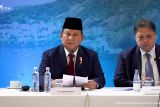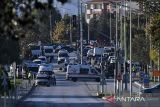Jakarta, March 7 (Antara) - President Joko Widodo (Jokowi) said Indonesia has two targets to be achieved in facing crisis in  power supply in the next five years.
The two targets are to build new power plants with power generating capacity of 35,000 megawatts and household electrification ratio to 100 percent by the end of 2019.
The president said the household electrification ratio is expected to reach 85 percent by the end of this year.
Based on data at the energy and mineral resource ministry, the electrification ratio was only 80 percent by the end of 2013.
          "Supply still falls short of demand ," Energy and Mineral Resources Minister Sudirman Said once said.
          However, a significant increase had been recorded in the electrification ratio, Sudirman noted. Â
    "In 1980, the ratio was only 8 percent , up in the following years to 28 percent in 1990, to 53 percent in 2000  and to 65.10 percent  by the end of 2008," he said.
   Â
Province Electrification Ratios
      However, based on data at the Directorate General of Electricity  and Energy Utilization (LPE), only 14 of the country's provinces have electrification ratios of more than 60 percent. They are Aceh (76,98 percent), North Sumatra (69.68 percent, West Sumatra (69.37 percent), Bangka Belitung (72.88 percent), Banten (63.90 percent) sen), Jakarta 100 percent, West Java 67.40 percent, Central Java 71.24 percent ,Yogyakarta 84.48 percent, East Java 71.55 percent, Bali (74.55 percent , East Kalimantan 68.56 percent , South Kalimantan 72.29 percent and North Sulawesi 66.87 percent.
          Sudirman said the government will build power plants where electrification ratios are the lowest.
          The electrification target is set at 3 million houses per year, that in 2020, electrification ratio will reach 99 percent, he said.
          "For example, the government will build 10 micro-hydro power plants each with a capacity of 5 MW in interior area of Papua (Lembah Baliem). Currently access road is being built to that area  that in 2018, ten regencies in the Central Papua could have power supply from the facilities  with a total generating facility of 10 x 5 MW," he said.
          Based on data at the energy and mineral resources ministry in 2013, the installed capacity of the country's power plants  was 34,205.63 MW --  growing 1,273 MW per year.
          "Additional capacity of more than 100 percent or 35,000 MW in five years or 7,000 MW a year is still needed ," he said.
          Additional capacity of 35,000 MW is needed to shore up  economic development with an annual growth of around 6 percent per year.
          "In order to meet the economic growth target, a 7.5 to 8 percent increase annually in the power generating capacity would be needed ," he said.
           Â
Involving private sector Â
      The minister said the target would not be easily reached. The plan to build new power plants has always been confronted with a lot of hurdles, notably land clearing , license , the readiness of contractors  and various legal issues. Â
      "The government has to step in to forestall crisis in power supply  in the next five years as PLN (state electricity company) could only build power plants with a total capacity of 14,600 MW during that period. The government, therefore, has to involve the private sector," he said.
            He said there are four steps to be taken by the government to meet the target in power generating capacity.
            The first is the introduction the system of  'One stop service' simplifying the licensing procedure for investors, he said.
            "The government has ruled the use of the system to serve 134 groups of licenses in 1,249 business areas including in electricity and industrial estates," he said.
            He said all licenses  could be processed directly at  the Capital Investment Coordinating Board (BKPM)  in Jakarta where there are representatives of related ministries  such as the ministry of agrarian affairs and layout  and  the environment and forestry ministry.
            The One Stop Service system was first adopted at BKPM on January 15 , 2015  with 19 ministries or government agencies having representatives placed there .
          In January, 2015 alone, there were 9 investors planning to invest in the electricity sector to build new power plants.
        The second step is regulation by the energy and mineral resources ministry . The electric energy directorate general already promoted a regulation of the minister  No. 3/2015  and decision of the ministerNo. 0074 K/21/MEM/2015.
          "The regulation of the minister is on the procedure of purchasing power  and the power reference price of PLN through direct appointment," the minister said.
          The ministerial decision constitutes a validation of the electric power procurement business plan RUPTL) of  PT PLN in 2015-2024.   Â
    "The two regulations were  drafted to expand the capacity to build power plants through  the mechanism of Independent Power Producer (IPP)," the minister said.
          The third steps is to implement the Law No. 2/ 2012 on the procurement of land for development for the public interest, he said.
          "I would propose  that the government could take part in the process of land clearing," he said.
          The fourth steps is  related to price negotiation  by determining price ceiling for IPP  and the government  will appoint IPP without going through tender.
          "Acceleration with direct appointment of the contractors is made in development of renewable energy projects , mine mouth power plant projects , marginal gas reserves  and expansion projects," he said. Â
   Â
Optimizing BPS
    Meanwhile, deputy chairman of the Commission VII of the Parliament Satya Widya Yudha proposed to the government optimization of data of the Central Bureau of Statistics to get accurate data related to the program of rural electrification.
          "By using  data from BPS, the government could see  how many villages which have been touched by the rural electrification program," Satya said in a discussion  on 'areas beset by electricity crisis,' and how to reach the target of building new power plants with a capacity of 35,000 MW.'
    He said so far electricity consumers  could be categorized into four groups - 'very rich, rich,  and poor people.
          Rural areas account for most of the people categorized as poor,  and BPS has data about areas the least to enjoy rural electrification program, he said.
          He said the government should give the priority for rural electrification until all households are fully covered by the program  and reach the electrification ratio of 100 percent.
          "In many villages some households  could not afford electricity, although their villages have been well covered by the rural electrification program," he said..***3***  (AS/a014)
Berita Terkait

PLN target selesaikan proyek sistem kelistrikan di Kalimantan
Kamis, 28 November 2024 8:41 Wib

Indonesia-Brazil Business Forum, Prabowo ungkap keunggulan Indonesia
Senin, 18 November 2024 11:58 Wib

Menteri Meutya Hafid: SATRIA-1 bisa penuhi target layani 20.000 titik
Kamis, 31 Oktober 2024 6:43 Wib

Turki berhasil hancurkan 32 target teroris di Irak dan Suriah lewat operasi udara
Kamis, 24 Oktober 2024 11:43 Wib

Israel lancarkan operasi darat di Lebanon selatan target kelompok Hizbullah
Selasa, 1 Oktober 2024 16:14 Wib

Tomohon - Minut turunkan stunting lampaui target nasional 14 persen
Selasa, 1 Oktober 2024 5:17 Wib

Kemenag target turunkan angka pernikahan dini di Bolmut
Kamis, 26 September 2024 22:07 Wib

Target 100 ribu kunjungan wisatawan di MotoGP Mandalika
Kamis, 26 September 2024 7:01 Wib


